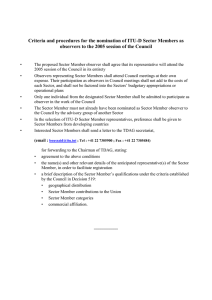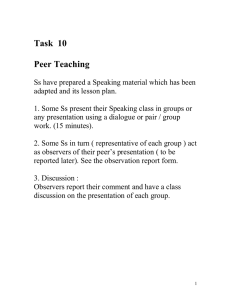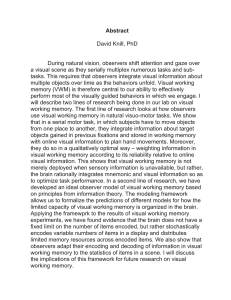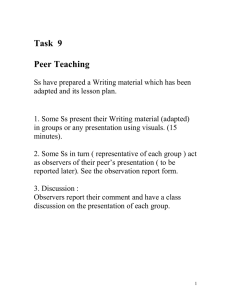Errors associated with using colored leg bands to
advertisement
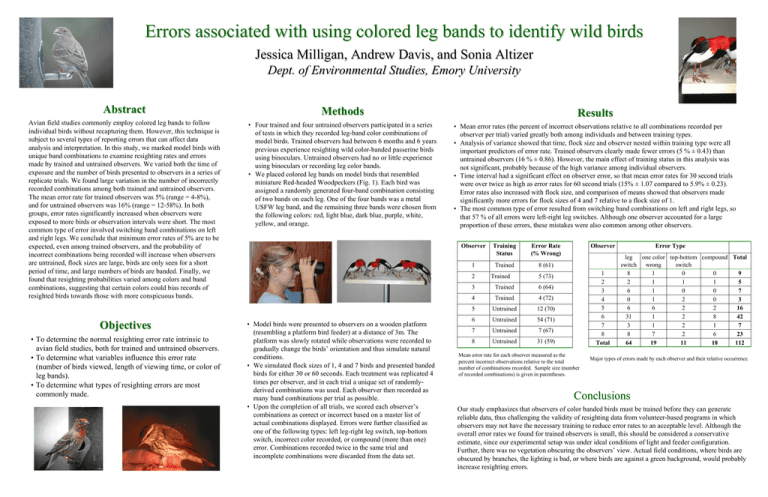
Errors associated with using colored leg bands to identify wild birds Jessica Milligan, Andrew Davis, and Sonia Altizer Dept. of Environmental Studies, Emory University Abstract Methods Avian field studies commonly employ colored leg bands to follow individual birds without recapturing them. However, this technique is subject to several types of reporting errors that can affect data analysis and interpretation. In this study, we marked model birds with unique band combinations to examine resighting rates and errors made by trained and untrained observers. We varied both the time of exposure and the number of birds presented to observers in a series of replicate trials. We found large variation in the number of incorrectly recorded combinations among both trained and untrained observers. The mean error rate for trained observers was 5% (range = 4-8%), and for untrained observers was 16% (range = 12-58%). In both groups, error rates significantly increased when observers were exposed to more birds or observation intervals were short. The most common type of error involved switching band combinations on left and right legs. We conclude that minimum error rates of 5% are to be expected, even among trained observers, and the probability of incorrect combinations being recorded will increase when observers are untrained, flock sizes are large, birds are only seen for a short period of time, and large numbers of birds are banded. Finally, we found that resighting probabilities varied among colors and band combinations, suggesting that certain colors could bias records of resighted birds towards those with more conspicuous bands. Results • Four trained and four untrained observers participated in a series of tests in which they recorded leg-band color combinations of model birds. Trained observers had between 6 months and 6 years previous experience resighting wild color-banded passerine birds using binoculars. Untrained observers had no or little experience using binoculars or recording leg color bands. • We placed colored leg bands on model birds that resembled miniature Red-headed Woodpeckers (Fig. 1). Each bird was assigned a randomly generated four-band combination consisting of two bands on each leg. One of the four bands was a metal USFW leg band, and the remaining three bands were chosen from the following colors: red, light blue, dark blue, purple, white, yellow, and orange. • Mean error rates (the percent of incorrect observations relative to all combinations recorded per observer per trial) varied greatly both among individuals and between training types. • Analysis of variance showed that time, flock size and observer nested within training type were all important predictors of error rate. Trained observers clearly made fewer errors (5 % ± 0.43) than untrained observers (16 % ± 0.86). However, the main effect of training status in this analysis was not significant, probably because of the high variance among individual observers. • Time interval had a significant effect on observer error, so that mean error rates for 30 second trials were over twice as high as error rates for 60 second trials (15% ± 1.07 compared to 5.9% ± 0.23). Error rates also increased with flock size, and comparison of means showed that observers made significantly more errors for flock sizes of 4 and 7 relative to a flock size of 1. • The most common type of error resulted from switching band combinations on left and right legs, so that 57 % of all errors were left-right leg switches. Although one observer accounted for a large proportion of these errors, these mistakes were also common among other observers. Objectives • To determine the normal resighting error rate intrinsic to avian field studies, both for trained and untrained observers. • To determine what variables influence this error rate (number of birds viewed, length of viewing time, or color of leg bands). • To determine what types of resighting errors are most commonly made. Observer Training Status Error Rate (% Wrong) 1 Trained 8 (61) 2 • Model birds were presented to observers on a wooden platform (resembling a platform bird feeder) at a distance of 3m. The platform was slowly rotated while observations were recorded to gradually change the birds’ orientation and thus simulate natural conditions. • We simulated flock sizes of 1, 4 and 7 birds and presented banded birds for either 30 or 60 seconds. Each treatment was replicated 4 times per observer, and in each trial a unique set of randomlyderived combinations was used. Each observer then recorded as many band combinations per trial as possible. • Upon the completion of all trials, we scored each observer’s combinations as correct or incorrect based on a master list of actual combinations displayed. Errors were further classified as one of the following types: left leg-right leg switch, top-bottom switch, incorrect color recorded, or compound (more than one) error. Combinations recorded twice in the same trial and incomplete combinations were discarded from the data set. Trained Observer 1 2 3 4 5 6 7 8 Total 5 (73) 3 Trained 6 (64) 4 Trained 4 (72) 5 Untrained 12 (70) 6 Untrained 54 (71) 7 Untrained 7 (67) 8 Untrained 31 (59) Mean error rate for each observer measured as the percent incorrect observations relative to the total number of combinations recorded. Sample size (number of recorded combinations) is given in parentheses. Error Type leg one color top-bottom compound Total switch wrong switch 8 1 0 0 9 2 1 1 1 5 6 1 0 0 7 0 1 2 0 3 6 6 2 2 16 31 1 2 8 42 3 1 2 1 7 8 7 2 6 23 64 19 11 18 112 Major types of errors made by each observer and their relative occurrence. Conclusions Our study emphasizes that observers of color banded birds must be trained before they can generate reliable data, thus challenging the validity of resighting data from volunteer-based programs in which observers may not have the necessary training to reduce error rates to an acceptable level. Although the overall error rates we found for trained observers is small, this should be considered a conservative estimate, since our experimental setup was under ideal conditions of light and feeder configuration. Further, there was no vegetation obscuring the observers’ view. Actual field conditions, where birds are obscured by branches, the lighting is bad, or where birds are against a green background, would probably increase resighting errors.

